Print On Demand Vs Dropshipping: Which One To Start?
In the ecommerce world, two business models dominate the market: Print on Demand (POD) and Dropshipping. Each model provides a special pathway to success. Choosing between Print on Demand Vs. Dropshipping is a complicated task.
Every aspiring entrepreneur who wants to explore electronic commerce fears dealing with inventory management, upfront costs, and product variety. It is where understanding the key points of these two business models becomes paramount.
Dropshipping eliminates the need for warehousing because all products are ordered from third parties and delivered directly to customers without vendor intervention.
Print on Demand (POD) is a model of electronic commerce where customers have to pre-order a specific product. No inventory is created beforehand, so there are no inventory concerns as with traditional mass production. This business model includes such goods as t-shirts, books, coffee mugs, etc.
This article will outline these e-commerce models and explore their pluses and minuses in detail. It will then guide you to make the best decision based on your business goals.
Table of Contents
Dropshipping Exploration
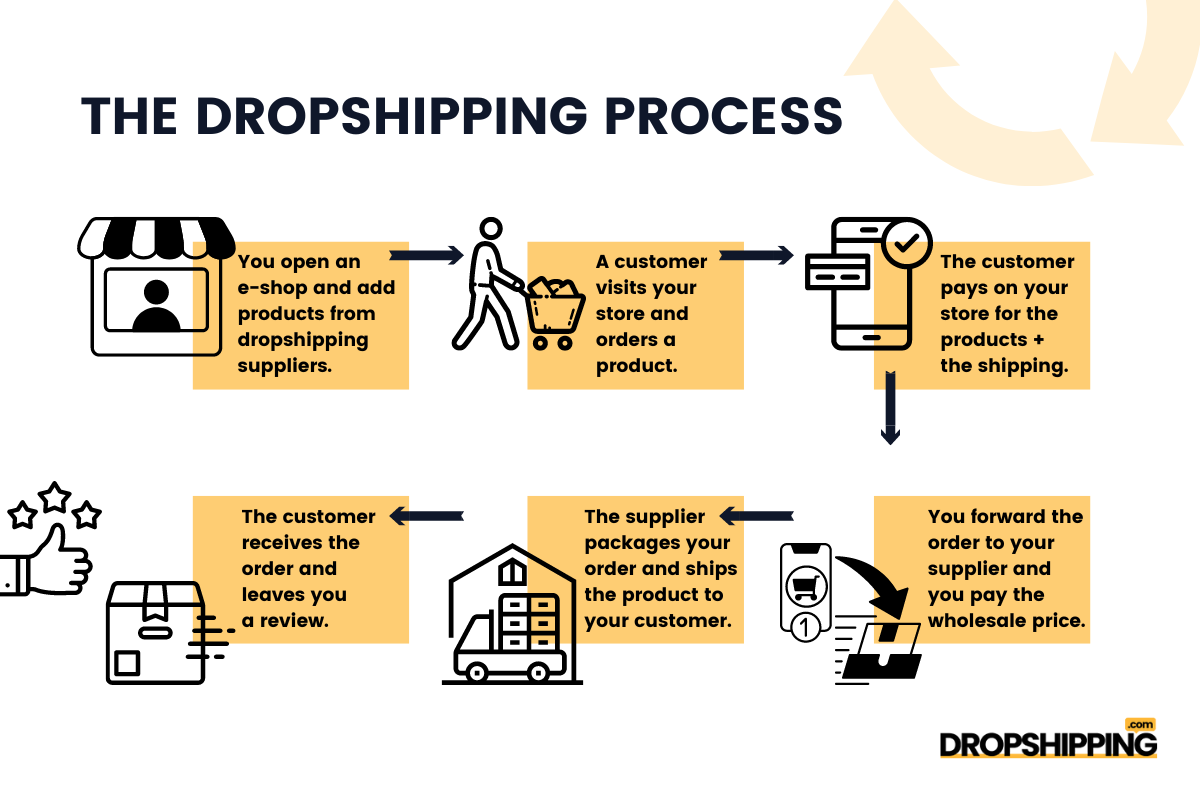
Dropshipping is a business model where a potential buyer purchases something from your online shop, after which you buy it from your suppliers, and they deliver it to customers.
Grand View Research confirms that the global Dropshipping market dimension was valued at USD 225.99 billion 2 years back and is anticipated to sign up a substance yearly development price (CAGR) of 23.4% within the following six years.
Also, based on the latest dropshipping statistics, the dropshipping market is expected to develop further, reaching $301.11 billion in 2024
In this section, we will delve into the strengths and weaknesses of this model and the reasons behind its growing popularity.
Pros of Dropshipping
✅ Low Upfront Investment and Running Costs
Dropshipping minimizes upfront investment and running costs compared to traditional retailing. This model is particularly attractive to beginners, allowing them to start a business with minimal budget outlay.
👉 Learn What Is The Minimum Budget To Start Dropshipping With Shopify?
✅ Efficient Inventory Management
The absence of physical inventory makes Dropshipping less labor-intensive and, therefore, easier to manage. With no need for a warehouse, suppliers take on the challenges of inventory tracking and management.
For example, if you need help tracking your inventory, I am personally using Inventory Source automation software.👇
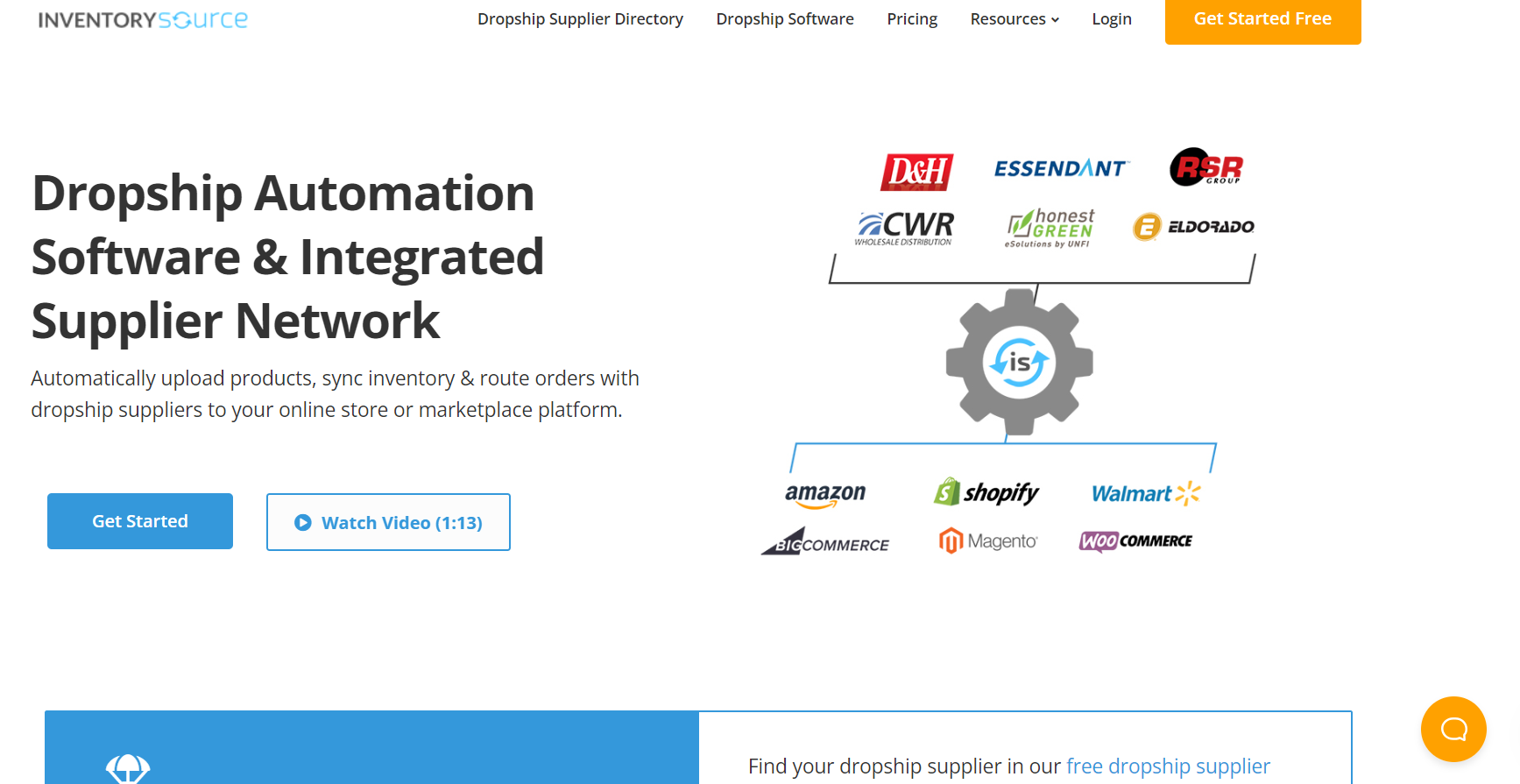
✅ Diverse Product Range
When it comes to print on demand vs dropshipping, this one makes difference.
Dropshipping eliminates the need to buy and store products beforehand, enabling sellers to offer a limitless range of items. There are no restrictions on what you can sell, providing flexibility and catering to diverse customer preferences.
For instance, AutoDS has a huge product directory where you can find winning products in any dropshipping niche.👇
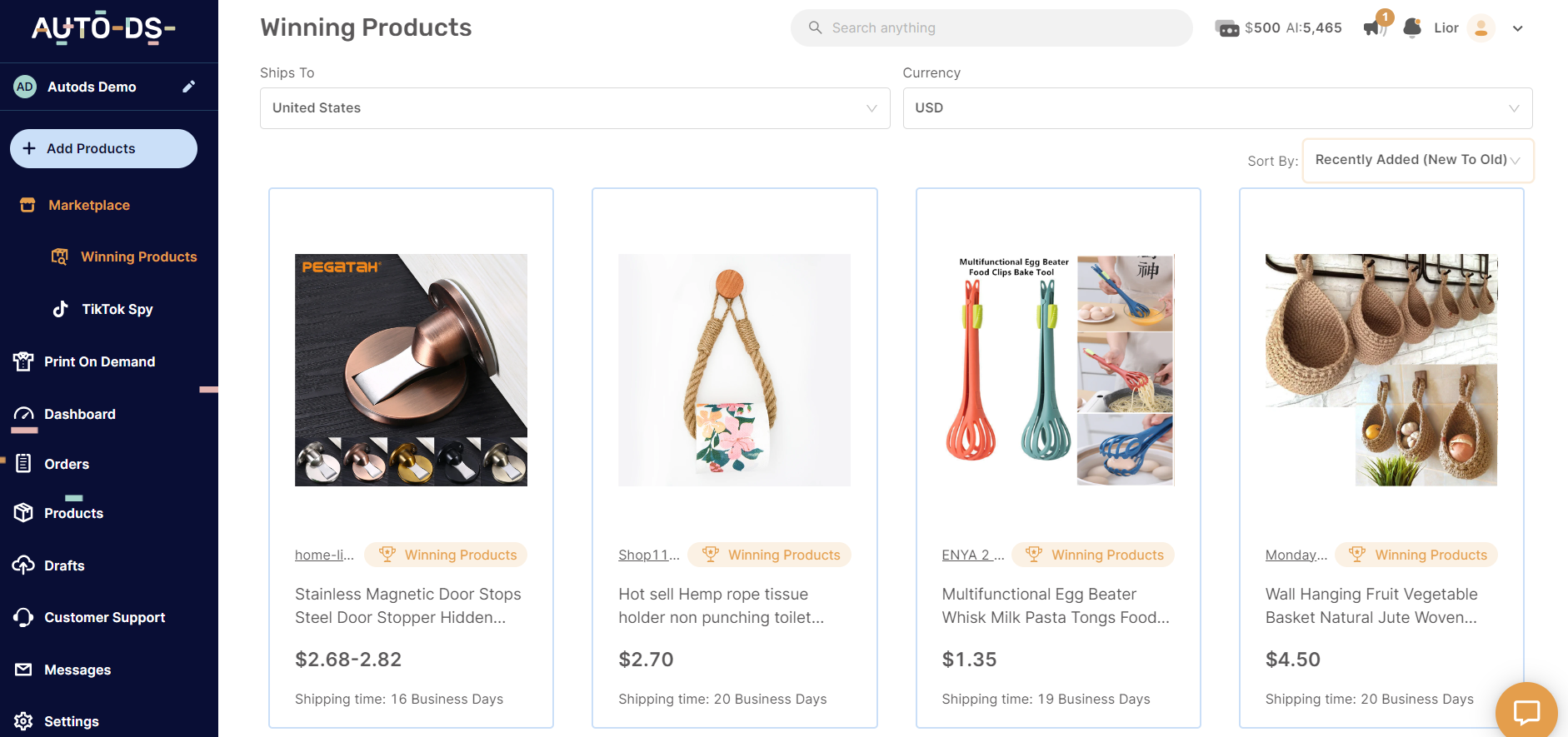
👉 Read my Ultimate Guide To Start With Woodworking Projects That Sell.
✅ Flexibility for Business Expansion
With Dropshipping, there are no limits on the amount of products you can store, and you don’t have to worry about unsold items.
This flexibility allows you to experiment with various marketplaces and product lines, facilitating easy business expansion.
✅ Remote Business Control
Dropshipping enables you to control your business from anywhere using the Internet. This versatility, combined with scalability, allows you to include new products in your shop without the concerns of storage or dealing with unsold inventory.
Cons of Dropshipping
❌ Intense Competition and Price Wars
Starting a Dropshipping business is easy, but the resulting high competition often leads to price wars.
This intense competitive environment can erode profit margins, posing a challenge to sustaining the business in the long term.
Therefore, I suggest you to use ad spy tools like Minea, Adserea, PipiADS, etc., and check on how your competitors are running their businesses.
Also, not all products are high-competitive. There are numerous dropshipping niches that are profitable and low competitive.
For example, I use Semrush to check on products’ keyword difficulty. So, if the keyword difficulty is low, so it is the competition. Hence, let’s try this out for my candle dropshipping business. 👇
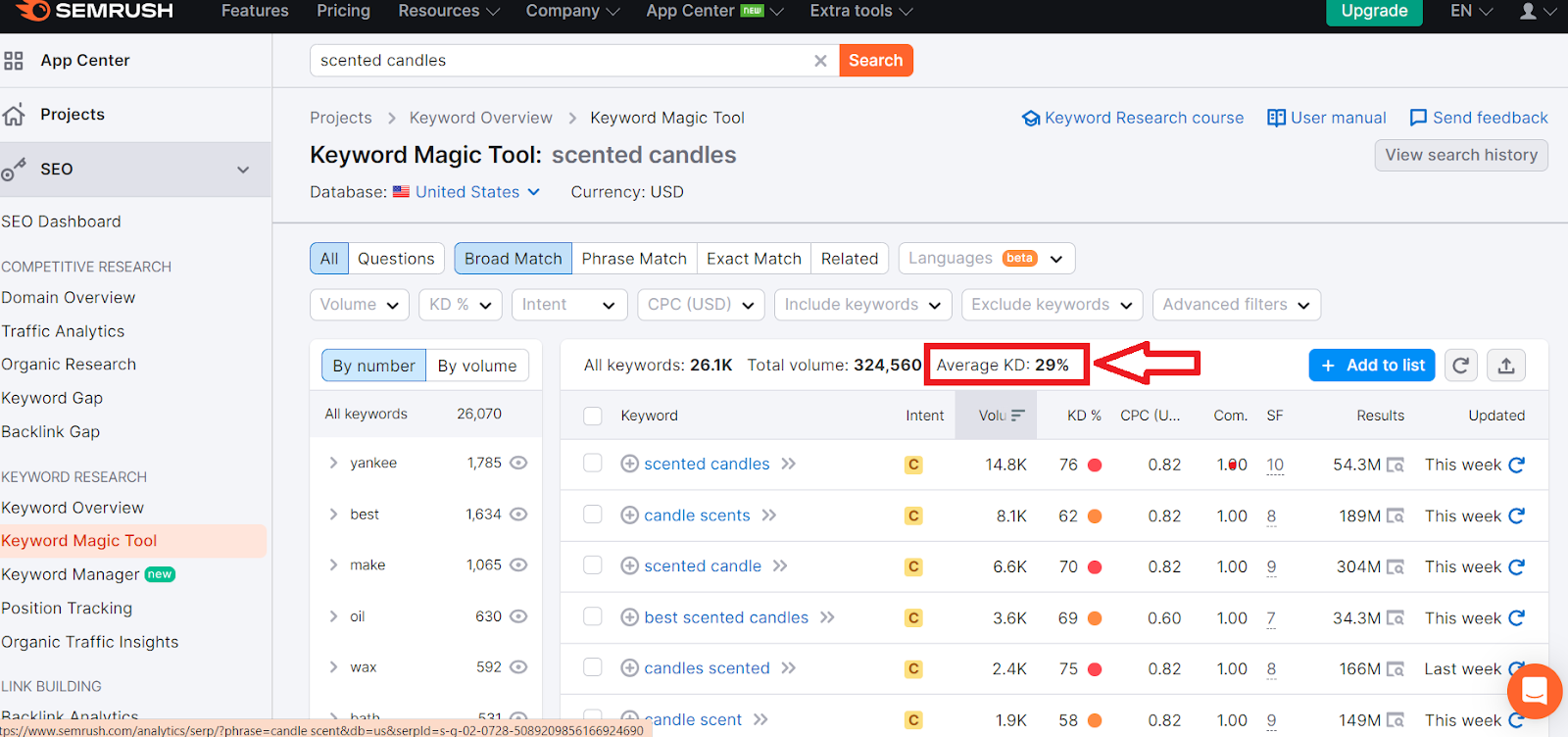
❌ Dependency on Third Parties for Inventory and Shipping
Dropshippers rely on third-party suppliers for inventory and shipping. Lack of direct control over inventory quality can negatively impact the brand’s reputation.
The business is vulnerable to issues beyond its control, affecting customer satisfaction.
However, there are numerous dropshipping apps for inventory management that are pretty affordable. For example, AutoDS pricing starts at only $19.90/month for Shopify integration.
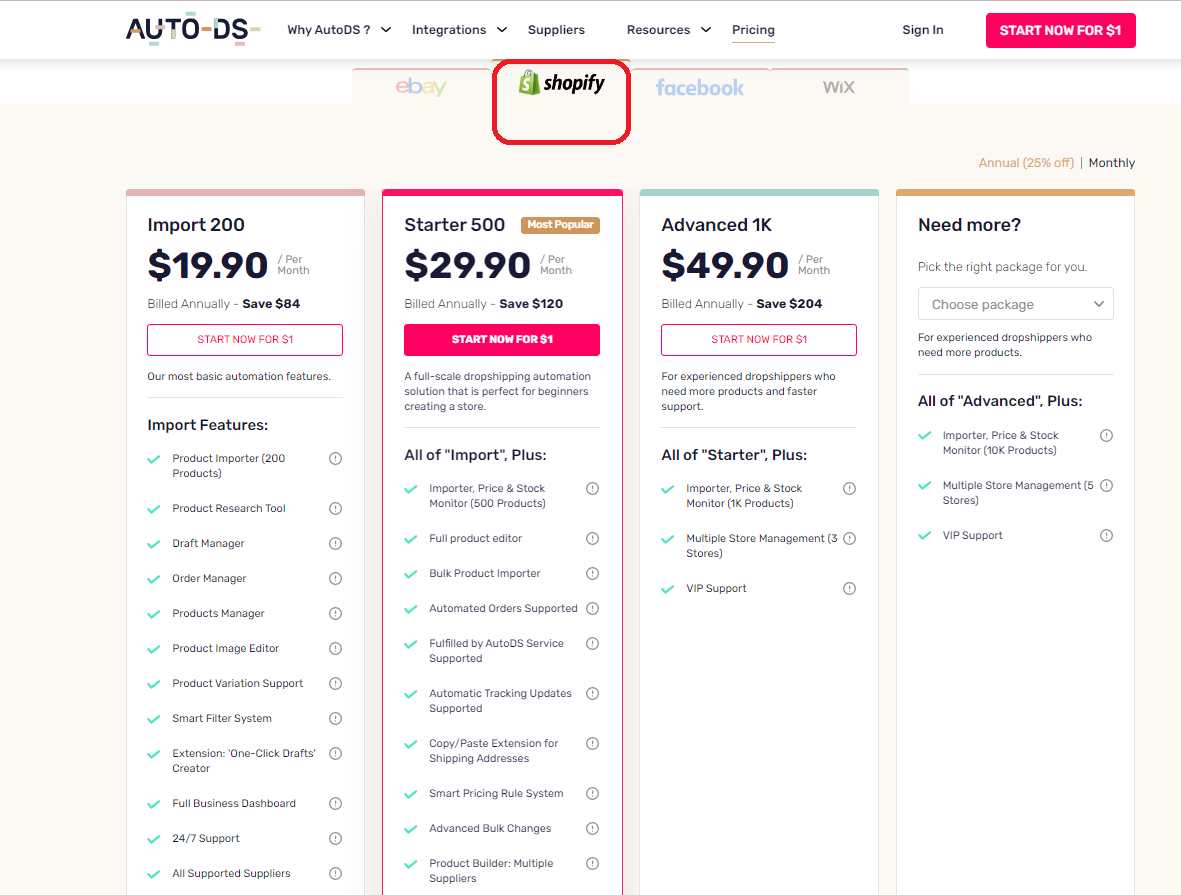
❌ Challenges in Building a Unique Brand
Building a unique brand with Dropshipping is challenging due to non-exclusive products available to other retailers.
Product differentiation becomes tough, limiting customization options. This may not appeal to customers seeking personalized and unique products.
❌ Complex Customer Service Handling
Customer service in Dropshipping can be complex, particularly when dealing with returns or shipping delays.
❌ Lack Of Control Over Shipping
The lack of control over shipping and handling processes may require significant time and effort to navigate these issues and maintain customer satisfaction.
❌ Limited Control Over Business Aspects
While Dropshipping provides an accessible entry into e-commerce, sellers face challenges related to the lack of control over pivotal aspects.
Therefore, effective supplier selection, strategic marketing, and a strong focus on customer service become crucial to overcome these inherent challenges.
In addition, I always find reliable suppliers in Dropshipping.com supplier directory. Plus their search filters are great! I can search based on niche, location, shipping costs, and more.
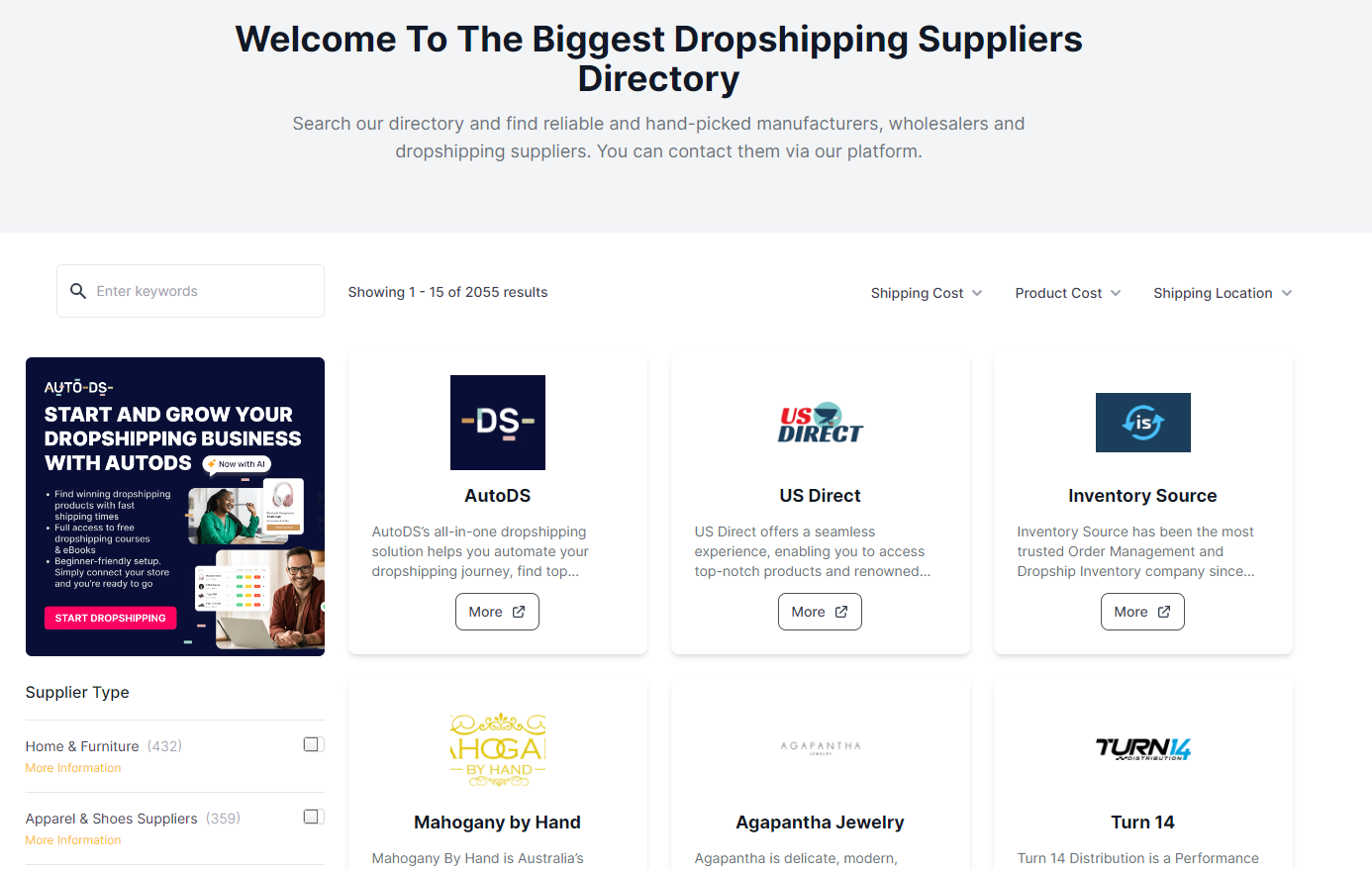
Dropshipping is a convenient E-commerce model, but the inability to control some pivotal aspects of their business makes sellers ask:
What is better than Dropshipping?
Seeking alternative ways to run their business successfully, sellers often turn to the Print on Demand model, which we will observe below.
Print on Demand: Customization Meets E-Commerce

In Print on Demand, you as a seller create or select the graphic arts and types of products. But you’re never obliged to invest in stock and manage service delivery. In this model, your product is produced only when a buyer makes an order.
This approach also greatly reduces the risks associated with unsold stock and ensures superior customization. From personalized t-shirts, pet products to personalized books and unique home décor, on-demand printing opens many opportunities for entrepreneurs and consumers.
Moreover, the POD market size could reach an amazing $10.17 billion in 2024.
This section looks at the pros and cons of Print on Demand as an e-commerce model.
👉 Check out the 16 Best Print On Demand Companies For Dropshippers In 2024.
Benefits of Print on Demand
✅ Zero Initial Inventory Investment
Both Print on Demand and Dropshipping eliminate the need for an initial investment in inventory.
This feature enables sellers to explore various styles and product types without significant upfront expenses or risks.
For example, Apliiq POD offers numerous print on demand products over various niches.

✅ Simplified Logistics Management
In Print on Demand, the service provider takes care of printing, packing, and shipping logistics.
This simplifies operations for sellers, allowing them to concentrate on design and marketing without the burden of managing these logistical aspects.
For example, at Printful, each product offers different ways to make it your own. You can choose where the print goes, pick the size, and select from a bunch of colors. 👇
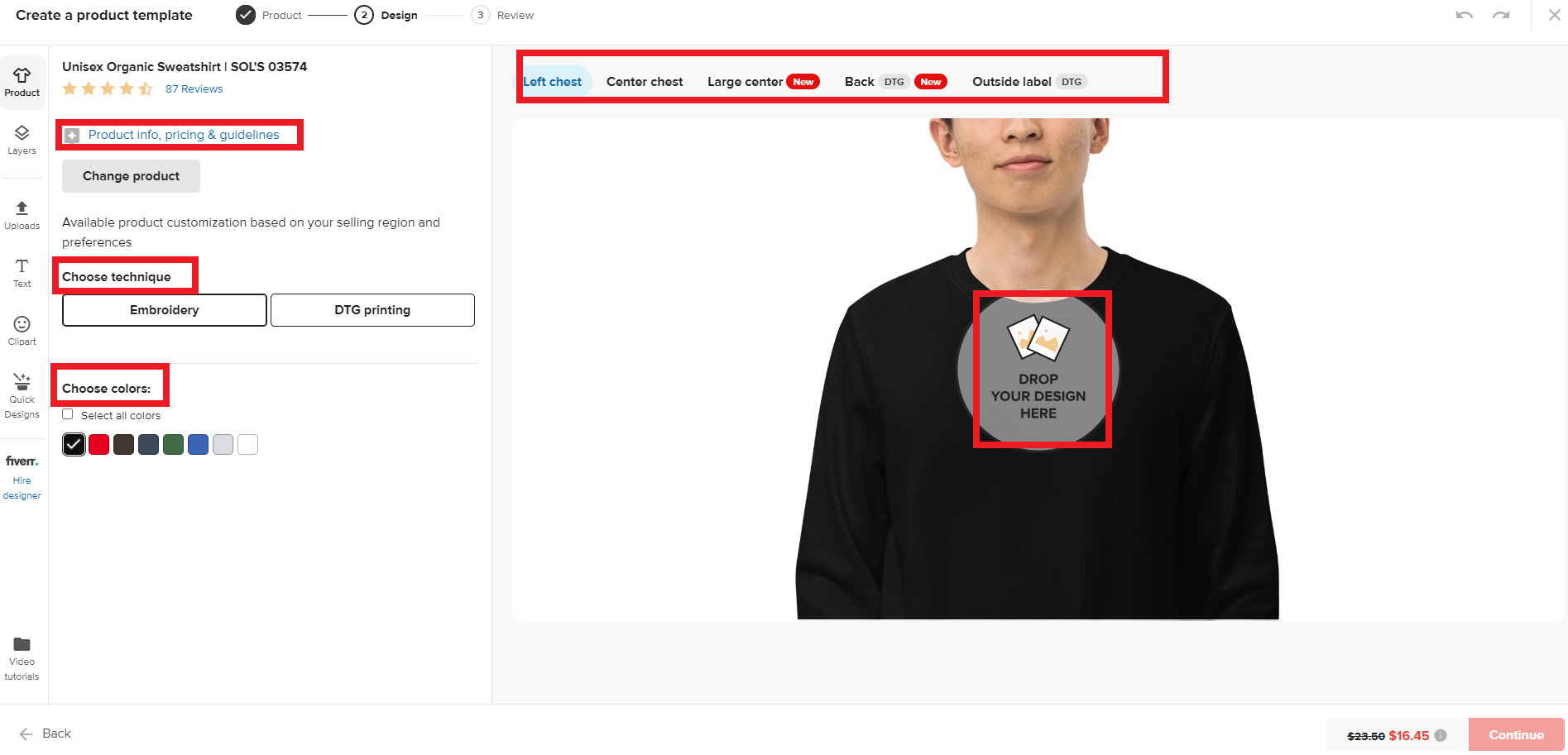
Plus, you can create your own templates for your products, making it easy to use them whenever you want. Moreover, the platform offers numerous branding options, and ships its products within 3-7 business days.
✅ Personalized Connection with Customers
By offering custom-made products, Print on Demand fosters a more personal connection with customers.
Also, sellers can cater directly to the preferences and needs of their audience, enhancing customer satisfaction and loyalty.
✅ Attractive to Artists, Designers, and Niche Markets
Print on Demand is particularly popular among artists, designers, and niche markets. It allows them to offer original products without the need for large-scale production or significant capital investment.
This model is also beneficial for testing market reactions to new designs or concepts before committing to larger production runs.
✅ Product selection
In this ecommerce model, product selection or creation is the seller’s responsibility. However, when it comes to print on demand vs dropshipping, there are differences.
So, the POD approach may be harder to manage, but the sellers are familiar with the goods they sell.
Print on Demand allows for strong branding opportunities as you can create unique, custom designs that stand out in the market.
So, whether tailoring designs to specific audiences or creating brand-centric merchandise, Print on Demand gives you the creative edge.
For example, this model works for photographers who sell their photos online. Also, seeing the audience’s reaction, they can improve their product quality using photo editing tools, such as AI image upscaler, without relying on third parties to run their business.
Also, Printify provides a fantastic mockup generator tool that lets you fully personalize your designs. This means you can effortlessly drag and drop your images and utilize the mockups on your online store and social media platforms.
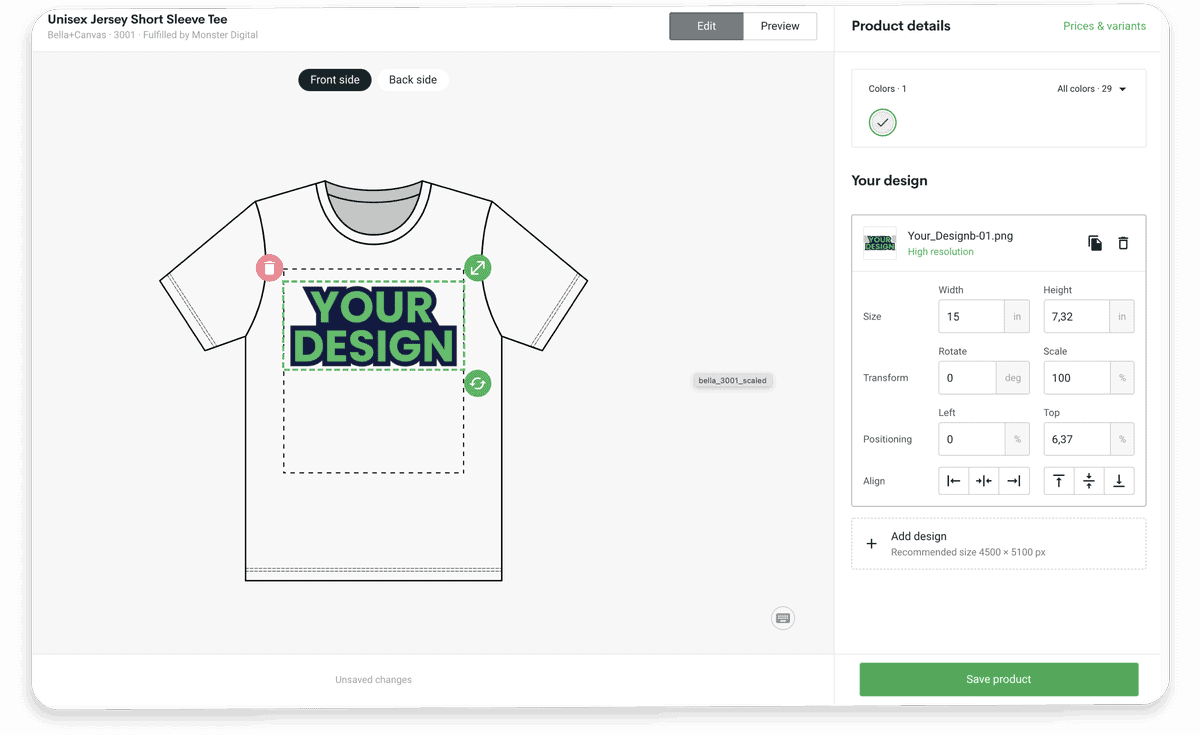
With no excess inventory, Print on Demand is a more sustainable and eco-friendly option. It reduces waste as products are only created when there is a demand. It can be an appealing selling point for environmentally conscious consumers.
Drawbacks of Print on Demand
❌ Higher Per-Item Production Cost
Although saving on inventory costs, Print on Demand often incurs a higher per-item production cost compared to bulk production.
This can result in lower profit margins per sale, impacting overall profitability.
In addition, take a look at this example of Apliiq’s pricing for a men’s t-shirt using their print on demand service. You can find similar tables on every product page in Apliiq’s catalog.👇
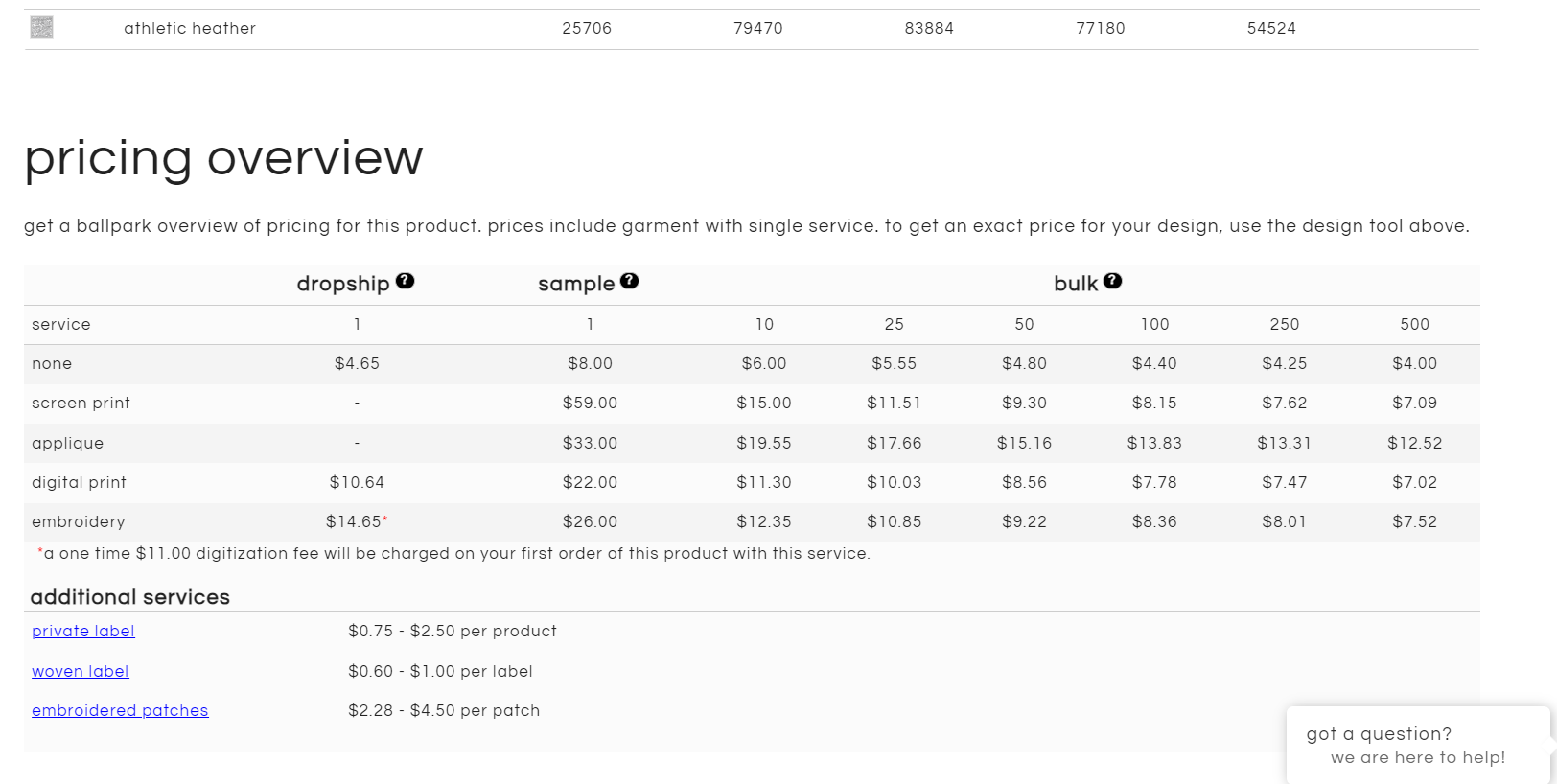
❌ Limited Control Over Production and Shipping
With production and shipping outsourced in Print on Demand, sellers have limited control over these processes.
This lack of control can potentially affect the overall customer experience, particularly in terms of production quality and shipping times.
❌ Diversity Constraints Compared to Dropshipping
While Print on Demand offers a wide range of customizable goods, it may not match the diversity available in Dropshipping.
Limitations in the types of products offered could impact the breadth of the market reach for sellers.
❌ Variable Product Quality
Depending on the chosen Print on Demand provider, product quality can vary.
Consistency is crucial for building a brand, and variations in quality may negatively impact the seller’s reputation over time.
❌ Extended Production and Shipping Times
Since Print on Demand products are made to order, production and shipping times can be longer compared to pre-made merchandise.
This longer turnaround time may be a potential drawback for customers expecting quick delivery.
❌ Challenges Require a Strategic Approach
While offering benefits, Print on Demand requires careful supplier selection, strategic pricing, and a well-thought-out marketing strategy to ensure profitability and customer satisfaction.
These considerations are crucial for success in this business model.
This model, especially popular among creative individuals utilizing their own designs, provides an accessible entry into e-commerce.
However, at the and of the day, Print on Demand is a fantastic model for entrepreneurs seeking an electronic commerce site without the hassle of managing inventory.
Print on Demand Vs. Dropshipping: What Works for You?
When deciding which model is better for your entrepreneurial journey, these are the primary factors to consider:
🔸 Investment and Risk Appetite
So, when it comes to print on demand vs dropshipping, let’s first talk about their investment and risks differences.
If you prefer minimal risk and investment, Dropshipping might be more suitable. This model allows for a lower financial threshold, making it ideal for those who are testing the waters of electronic commerce or are hesitant to invest large sums without guaranteed returns.
Nevertheless, business owners are going to spend much more on items of high quality as well as brand name individuality. Print on Demand uses a system to display creativity and construct a unique brand name visibility.
While the first expenses might be greater, the lasting incentives of brand name commitment and consumer fulfillment can be significant.
🔸 Control Over Products
Control substantially influences electronic commerce’s success. With Print on Demand, you can determine your items’ looks plus top quality, guaranteeing that each thing mirrors your brand name’s principles. It is essential for services whose brand name approach focuses on one-of-a-kind, top-quality items.
On the other hand, Dropshipping supplies much less control over item choice together with high quality yet makes up with an extra simple, functional version. It can benefit business owners aiming to focus more on advertising, marketing, and client purchases than item growth.
🔸 Market Niche
The preferences and expectations of your target audience are pivotal in determining which model to adopt. Print on Demand thrives in markets where customization, originality, and design are highly valued. This model allows for deep connections with niche audiences who appreciate the unique value offered.
Conversely, Dropshipping can be advantageous in markets where variety and price competitiveness play an important role. It is perfect for entrepreneurs targeting a broader audience with different needs and budgets.
🔸 Business Goals and Long-Term Vision:
When it comes to print on demand vs dropshipping, positioning your business model with your long-term goals is pivotal for long-term success.
So, if your vision includes developing a solid brand name identification as well as producing a dedicated consumer base about distinct items, Print on Demand is your ally.
It allows for the growth of a particular brand story and customer experience.
However, if you want to reach a wide audience quickly, maximize product variety, and streamline operations, Dropshipping aligns better with these objectives. It offers the flexibility to adapt to market trends without the burden of inventory management.
Conclusion
When in doubt between print on demand vs dropshipping, let’s sum it all up.
Dropshipping is a model that sticks out for its reduced access obstacles, operational adaptability, and scalability. It is the best selection for those who want to attempt e-commerce without a substantial ahead of time financial investment.
Nonetheless, this simplicity of entrance includes the concessions of reduced revenue margins because of extreme competitors and much less control over stock coupled with delivering procedures.
On the other hand, Print on Demand offers highly customized products with no inventory risks, particularly appealing to creative entrepreneurs promoting their artwork.
While Print on Demand allows for more product control and brand building, it presents challenges: higher production costs per item and potential variability in product quality.
The success in either model relies on effective marketing, excellent customer service, and a deep understanding of your market. Print on Demand and Dropshipping stand as viable models for entrepreneurs in the ever-evolving electronic commerce landscape.
The decision between them should be based on carefully assessing your strengths, business objectives, and the unique value you wish to offer your customers.













![The Top 21 3PL Companies Compared [2024 List & Guide]](https://images.weserv.nl/?url=https://prod-dropshipping-s3.s3.fr-par.scw.cloud/2024/03/Frame-3922469.jpg&w=420&q=90&output=webp)